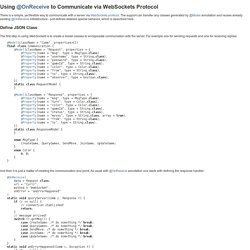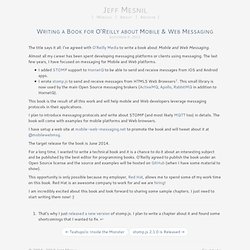

WebSockets via @OnReceive. There is a simple, yet flexible way to communicate with a server via WebSockets protocol.

The support can transfer any classes generated by @Model annotation and reuses already existing @OnReceive infrastructure - just defines detailed special behavior, which is described here. Define JSON Class The first step in using WebSockets is to create a model classes to encapsulate communiation with the server. For example one for sending requests and one for receiving replies: And then it is just a matter of creating the communication end point. The WebSockets specification usually defines what should happen onopen, onmessage, onclose and onerror. One cannot change the URL while a connection is open otherwise one risks IllegalStateException runtime exceptions.
Codeurs en Seine 2015 Appel à Orateurs - Codeurs en Seine. On the path to Wisdom. Continuous delivery with docker containers and Java EE. Twitter. Securing WebSockets using Username/Password and Servlet Security (Tech Tip #49) RFC 6455 provide a complete list of security considerations for WebSockets.

Some of them are baked in the protocol itself, and others need more explanation on how they can be achieved on a particular server. Lets talk about some of the security built into the protocol itself: The Origin header in HTTP request includes only the information required to identify the principal (web page, JavaScript or any other client) that initiated the request (typically the scheme, host, and port of initiating origin).
For WebSockets, this header field is included in the client’s opening handshake. This is used to inform server of the script origin generating the WebSocket connection request. In addition to these two primary ways, WebSockets can be secured using client authentication mechanism available to any HTTP servers. Lets get started! WebSphere:WASdev:Profilemanagement Tool for WAS 8.5 beta fails.. Jeff Mesnil — How To Shoot a Bottle of Beer — St. Stefanus Blonde. September 5, 2014 For the past 18 months, I have photographed bottles of beer for my friends of Une Petite Mousse.

On their web site, you subscribe to receive every month a box of six bottle of beers. The selection changes every month and contains a mix of well-known beers and others from micro-breweries. It is a great way to discover and taste new beers that you can not find in a store near you. They need pictures of the bottles for their online catalogue and the paper guide that comes in the boxes. Making photographs of a bottle of beer is suprisingly challenging. In this post, I'll explain the process I haved used for the latest box (available mid-september). The picture above is from their web site (I really like how the strips of white emphasize the roundness of the small bottle). Gear To photograph this bottle, I used the following material: Load Balancing WebSocket using Apache HTTPD and WildFly. Tyrus 1.8 (Pavel Bucek's weblog) Java API for WebSocket 1.1 (The Aquarium) Tyrus 1.6 (Pavel Bucek's weblog)
Devoxx%20France%202014%20Web%20Performances%20EN. 8 Final is released! · WildFly. Arungupta : #WebSocket talk is third best... Jeff Mesnil — Writing a Book for O'Reilly about Mobile & Web Messaging. September 9, 2013 The title says it all: I've agreed with O'Reilly Media to write a book about Mobile and Web Messaging.

Almost all my career has been spent developing messaging platforms or clients using messaging. The last few years, I have focused on messaging for Mobile and Web platforms. I added STOMP support to HornetQ to be able to send and receive messages from iOS and Android apps. I wrote stomp.js to send and receive messages from HTML5 Web Browsers1. Stomp.js 2.1.0's simplified API. Carrieres. Episode 77 - Google par-ci Google par la. Jkbr/httpie. Cloudhead/http-console. Looking for two web talents « jb at mozilla.
Testing made easier in Internet Explorer. Online Tools. Zaproxy - OWASP ZAP: An easy to use integrated penetration testing tool for finding vulnerabilities in web applications. The OWASP Zed Attack Proxy (ZAP) is an easy to use integrated penetration testing tool for finding vulnerabilities in web applications.

It is designed to be used by people with a wide range of security experience and as such is ideal for developers and functional testers who are new to penetration testing as well as being a useful addition to an experienced pen testers toolbox. ZAP 2.3.0 is now available! Download it here: ZAP is taking part in the Google Summer of Code 2014. See the OWASP wiki for suggested projects. ZAP Is the Top Security Tool of 2013 as voted by ToolsWatch.org readers! And you can now buy ZAP related gear in the, er, ZAP Gear Store! Latest ZAP Tutorial video: Overview and Simon's talk from Appsec USA covering Plug-n-Hack and Zest: The official OWASP ZAP homepage is on the OWASP site. This Google Code project is used for the downloads, wiki, online help pages, links to videos, issues and source code. The Web engineer's online toolbox. Securing RESTful Web Services with OAuth2. As an active committer on Spring Security OAuth and the Cloud Foundry UAA, one of the questions I get asked the most is: “When and why would I use OAuth2?”

The answer, as often with such questions, is “it depends.” However, I must admit, there are some features of OAuth2 that make it compelling in a wide variety of situations, especially in systems composed of many lightweight web services. This article guides you through updating a system to be secured with OAuth2 and the decision points for choosing to build such a system.
Javascript.